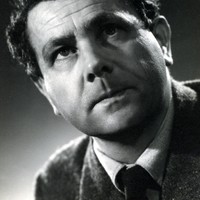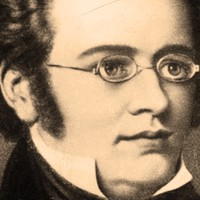Details

Gerald Finzi
Romance
British composer Gerald Finzi spent most of his life in the English countryside, where he divided his time between writing music and growing apples. In fact, he saved a number of rare English apple varieties from extinction. By the time he was eighteen, Finzi had lost his beloved music teacher, his father, and all three of his brothers. These early tragedies profoundly impacted him, and much of his music is elegiac in style.
Finzi’s Romance is a single-movement work that dates to 1928, although it was not premiered until 1951. Romance begins with a calm stillness, which unfolds to an intense climax before gently morphing back to music that is reminiscent of the opening. The entire work, which is decidedly English in style, is permeated with raw emotion, yearning, and deep passion. Finzi was particularly well-known for his choral writing, and the Romance demonstrates his ability to create stunningly languid and inventive melodies.
Finzi’s career and compositions have often been overshadowed by his English contemporaries, especially those of Ralph Vaughan Williams and Edward Elgar. Yet Finzi’s works are just as well-written and poignantly expressive as other music from the time. Before his death at age 55, he wrote song cycles, art songs, choral works, chamber works and concertos for violin, cello and clarinet.
Paula Maust ©2022

Benjamin Britten
Serenade for Tenor, Horn and Strings
Although Benjamin Britten described his 1943 Serenade for Tenor, Horn and Strings as “not important stuff,” the piece was immediately popular and helped establish him as one of the leading British composers of his time. Initial sketches for the Serenade were devised while Britten was in the hospital and was written for tenor Peter Pears and horn virtuoso Dennis Brain. Pears, who was also Britten’s long-time romantic partner, inspired many of Britten’s works.
A serenade is a musical greeting, which is often performed in the evening to honor a beloved person of rank. Britten is highly regarded for his musical settings of English texts, and the Serenade includes six texts by a variety of English poets. These vocal movements are bookended by a solo horn prologue and epilogue. Each movement is evocative of nighttime, and the cycle takes the audience on a journey that encompasses the passage of time, love, illness, desperation, shadows, prayer, and death.
Throughout the Serenade, the horn plays passages that are both regal and heartbreakingly vocal. Often, the horn functions as the tenor’s shadow. The opening Prologue is written in the style of the older natural horn, which had no valves and only played notes from the overtone series. This creates an eerie, open sound that connects the listener to nature.
The Pastoral, a romantic portrayal of a bucolic scene, includes text by the seventeenth-century poet Charles Cotton. Britten sets this movement in triple meter, which is common for pastoral songs. The strings, however, are in duple meter at the opening of the movement, which creates tension and suggests that there will be challenges ahead. Themes of light and shadows emerge in the poetry, and nightfall arrives at the end.
A nocturne is a piece that evokes nighttime, and Britten sets a poem by Alfred Tennyson in his Nocturne movement. This section of the Serenade is composed of two distinct musical ideas that alternate throughout the movement. The first contains high, bright chords in the strings, while the second is more relaxed and does not have a strict pulse.
The Elegy, which is a musical offering to the dead, uses a text by William Blake. This sinister movement features poignant melodies and a persistent conflict between major and minor sonorities.
Dirges are typically solemn, plodding burial songs, but Britten’s Dirge is more reminiscent of a frenzied torment. The text comes from an anonymous fifteenth-century poem, and the movement strikingly opens with the tenor singing a capella (without instrumental accompaniment). At the end of the first verse, the strings enter quietly, and the horn does not sound until its passionate entrance in verse six.
The atmosphere is temporarily lightened during the Hymn, which sets a text by Ben Johnson. This sweet movement is full of optimism and gratitude as the protagonist implores the Goddess to bring light. The tenor line has its first melisma (one syllable sung on consecutive moving notes) in the Hymn, which offers a glimmer of sunshine amidst the darkness.
Daybreak has not arrived, however, when we reach the Sonnet. In the emotive text by John Keats, the narrator is humbled in the face of death and enters an eternal slumber. The Sonnet is built on an ostinato, which is a constantly-repeated musical figure. Both beauty and anguish are portrayed throughout the movement. The tenor has a florid melodic line that descends, stylistically recalling the hopefulness of the Hymn, but ultimately culminating in death.
To mark the conclusion of the journey into darkness, the Serenade closes with the horn’s solo Epilogue.
Lyrics
I. Prologue
(solo horn)
II. Pastoral
The day’s grown old; the fainting sun Has but a little way to run, And yet his steeds, with all his skill, Scarce lug the chariot down the hill.
The shadows now so long do grow, That brambles like tall cedars show; Molehills seem mountains, and the ant Appears a monstrous elephant.
A very little, little flock Shades thrice the ground that it would stock; Whilst the small stripling following them Appears a mighty Polypheme.
And now on benches all are sat, In the cool air to sit and chat, Till Phoebus, dipping in the West, Shall lead the world the way to rest.
Charles Cotton (1630–1687)
III. Nocturne
The splendour falls on castle walls And snowy summits old in story: The long light shakes across the lakes, And the wild cataract leaps in glory:
Blow, bugle, blow, set the wild echoes flying, Bugle blow; answer, echoes, dying, dying, dying.
O hark, O hear, how thin and clear, And thinner, clearer, farther going! O sweet and far from cliff and scar The horns of Elfland faintly blowing!
Blow, let us hear the purple glens replying: Bugle, blow; answer, echoes, answer, dying, dying, dying.
O love, they die in yon rich sky, They faint on hill or field or river: Our echoes roll from soul to soul, And grow for ever and for ever.
Blow, bugle, blow, set the wild echoes flying; And answer, echoes, answer, dying, dying, dying.
Alfred, Lord Tennyson (1809–1892)
IV. Elegy
O Rose, thou art sick; The invisible worm That flies in the night, In the howling storm,
Has found out thy bed Of crimson joy; And his dark, secret love Does thy life destroy.
William Blake (1757–1827)
V. Dirge
This ae nighte, this ae nighte, Every nighte and alle, Fire and fleet and candle‑lighte, And Christe receive thy saule.
When thou from hence away art past, Every nighte and alle, To Whinnymuir thou com'st at last; And Christe receive thy saule.
If ever thou gav'st hos'n and shoon, Every nighte and alle, Sit thee down and put them on; And Christe receive thy saule.
If hos'n and shoon thou ne'er gav'st nane Every nighte and alle, The whinnes sall prick thee to the bare bane; And Christe receive thy saule.
From Whinnymuir when thou may'st pass, Every nighte and alle, To Brig o' Dread thou com'st at last; And Christe receive thy saule.
From Brig o' Dread when thou may'st pass, Every nighte and alle, To Purgatory fire thou com'st at last; And Christe receive thy saule.
If ever thou gav'st meat or drink, Every nighte and alle, The fire sall never make thee shrink; And Christe receive thy saule.
If meat or drink thou ne'er gav'st nane, Every nighte and alle, The fire will burn thee to the bare bane; And Christe receive thy saule.
This ae nighte, this ae nighte, Every nighte and alle, Fire and fleet and candle‑lighte, And Christe receive thy saule.
Lyke Wake Dirge, Anonymous (15th century)
VI. Hymn
Queen and huntress, chaste and fair, Now the sun is laid to sleep, Seated in thy silver chair, State in wonted manner keep: Hesperus entreats thy light, Goddess excellently bright.
Earth, let not thy envious shade Dare itself to interpose; Cynthia's shining orb was made Heav'n to clear when day did close: Bless us then with wishèd sight, Goddess excellently bright.
Lay thy bow of pearl apart, And thy crystal shining quiver; Give unto the flying hart Space to breathe, how short so-ever: Thou that mak'st a day of night, Goddess excellently bright.
Ben Jonson (1572–1637)
VII. Sonnet
O soft embalmer of the still midnight, Shutting with careful fingers and benign Our gloom‑pleas'd eyes, embower'd from the light, Enshaded in forgetfulness divine:
O soothest Sleep! if so it please thee, close In midst of this thine hymn my willing eyes, Or wait the “Amen” ere thy poppy throws Around my bed its lulling charities.
Then save me, or the passèd day will shine Upon my pillow, breeding many woes, Save me from curious Conscience, that still lords
Its strength for darkness, burrowing like a mole; Turn the key deftly in the oilèd wards, And seal the hushèd Casket of my Soul.
John Keats (1795–1821)
VIII. Epilogue
(solo horn — off stage)
Paula Maust ©2022

Wolfgang Amadeus Mozart
“Un’aura amorosa del nostro tesoro” from Così fan tutte
Due to an obligatory period of mourning for the death of Emperor Joseph II, Wolfgang Amadeus Mozart’s opera Così fan tutte only ran for five nights during its January 1790 premiere in Vienna. Così fan tutte, which is sometimes translated as “women are like that,” is a light, comic Italian opera in two acts with a libretto by Lorenzo Da Ponte.
The opera’s primary plot focuses on two military officers, Ferrando and Guglielmo, and their fiancées, Dorabella and Fiordiligi. The officers are certain that their fiancées will remain faithful forever, but their friend Don Alfonso is skeptical. He bets the two officers that he can prove within a day that all women, including Dorabella and Fiordiligi, are fickle. The three men devise a witty farce in which the officers pretend to leave for war. Shortly thereafter, the officers return disguised as Albanians, and each man endeavors to seduce the other’s lover.
When Ferrando sings “Un'aura amorosa del nostro Tesoro,” he has not yet been successful in wooing Guglielmo’s fiancée, but he is feeling confident about his chances. Indeed, both women eventually acquiesce and flirt with the disguised Albanians. The final scenes of the opera contain a fictitious wedding between the women and the Albanians, which is cleverly interrupted by the return of the officers. Don Alfonso has won his bet, and he urges Ferrando and Guglielmo to absolve Dorabella and Fiordiligi, since after all, “cosi fan tutte” (all women are like that). At the opera’s conclusion, all is forgiven, and the original couples are happily reunited.
Lyrics
Un’aura amorosa
Del nostro tesoro
Un dolce ristoro
Al cor porgerà;
Al cor che, nudrito
Da speme, da amore,
Di un’esca migliore
Bisogno non ha.
A breath of love
From our treasures
Will offer sweet sustenance
To our hearts
A heart nourished
By hope, by love
Has no need
Of a greater lure.
Paula Maust ©2022

Wolfgang Amadeus Mozart
“Se all'impero amici Dei” from La clemenza di Tito
When it was time to plan the celebrations for Emperor Leopold II’s coronation as King of Bohemia, the impresario Domenico Guardasoni reached out to the most sought-after Italian opera composer in Vienna — Antonio Salieri. The popular composer declined the commission, however, which resulted in Guardasoni hiring his second choice to write the congratulatory opera — Wolfgang Amadeus Mozart.
Mozart’s La clemenza di Tito (The Clemency of Titus) is a serious opera in two acts with a libretto by Pietro Metastasio and Caterino Mazzolà. There is some disagreement about how long Mozart took to compose the opera, but many believe it was written quite quickly, perhaps in as few as eighteen days. One of Mozart’s last works, La clemenza di Tito was premiered a few hours after Leopold II’s coronation on September 6, 1791 in Prague. It was during his visit to Prague for this performance that Mozart fell ill with the sickness that would tragically take his life three months later, when he was just thirty-five years old.
La clemenza di Tito is based on the life of the Roman Emperor Titus (Tito). Vitellìa, the daughter of the late emperor Vitellio, wants to enact revenge on Tito for killing her father. She also wants Tito to fall in love with her and make her his new empress. When Tito chooses another woman, Vitellìa jealousy reacts and convinces her friend Sesto to assassinate Tito. A chaotic fire then breaks out in the Capitol, during which Sesto claims to have seen Tito murdered.
In the second act, however, the truth comes out — Sesto attacked another man dressed in Tito’s robes during the fire, and Tito is not dead. The attacked man also survives, and Sesto is found guilty of attempted murder. Tito is then responsible for signing Sesto’s death sentence, which causes him great anguish. Unwilling to authorize his friend’s death, Tito sings “Se all'impero amici Dei” and declares that he would rather be accused of showing too much mercy than of acting out of spiteful vengeance. All are forgiven, including Vitellìa, and the opera ends with everyone giving thanks for Tito’s generosity.
Lyrics
Se all’impero, amici dei,
necessario è un cor severo,
o togliete a me l’impero
o a me date un altro cor.
Se la fé de’ regni miei
con l’amor non assicuro,
d’una fede io non mi curo
che sia frutto del timor.
If a strict, unfeeling heart
is needed in order to rule,
either take from me the empire
or else give me another heart.
If the faith of my realm
I cannot secure with my love,
I care nothing for their loyalty
if it is merely the product of fear.
Paula Maust ©2022

Franz Schubert
Symphony No. 6, The Little C Major
In 1817, German composer Franz Schubert had left his teaching position at his father’s school and was working to establish his career as a freelance composer in Vienna. Neapolitan operas, particularly those by Gioachino Rossini, were wildly popular in Vienna at the time. Eager to compose pieces that would sell to the general public, Schubert wrote a number of works emulating the Italian style, including his Symphony No. 6.
Symphony No. 6 was written between October 1817 and February 1818. The piece is sometimes called “The Little C Major” in order to differentiate it from his later “Great C Major” Symphony No. 9. None of Schubert’s symphonies were publicly performed or published until after his death in 1828. In fact, Symphony No. 6 was only premiered in December 1828 because the Society of the Friends of Music in Vienna found Schubert’s Symphony No. 9 to be too difficult to learn in time for their upcoming performance. At the last minute, they chose to play Symphony No. 6 instead.
Although Symphony No. 6 demonstrates Schubert’s brilliant ability to craft exquisite melodies, the work has received decidedly mixed reviews. A critic at the premiere wrote that it was “a fine, diligently crafted work whose most appealing movements are the Scherzo and the Finale.” Later in the century, however, musicologist Ernest Newman wrote: “Is the succession of charming little tunes known as Schubert’s sixth symphony a festival work? Not, I grieve to say, for me. When one knows in advance exactly what will happen four bars hence…the suspense of waiting for the expected becomes positively nerve-racking.”
After a slow, expectant Adagio introduction, the Symphony moves into a cheerful, quick Allegro with Italianate themes. The conversational dialogue between the solo woodwinds and strings is a convention at which Schubert excelled, and the movement ends with noisy grandeur similar to a Rossini opera overture. The sentimental Andante opens with a lilting theme, which is then contrasted with a more intense section that features insistent triplets.
As the nineteenth century progressed, the traditional Minuet and Trio that was typically found in the third movement of symphonies was often replaced with a scherzo. Schubert’s symphonies illustrate this stylistic trend as well, with Symphony No. 6 being his first symphony to have a scherzo for the third movement. Many have compared this particular movement from Symphony No. 6 to Beethoven’s symphonic scherzos. Schubert’s Scherzo is quite energetic and playful, qualities one expects in these witty, joke-like movements. Symphony No. 6 concludes with a bright, animated Finale with clever orchestration.
Paula Maust ©2022
About This Program
Artistic Partner Richard Egarr returns with a program that opens with works by British composers, including Benjamin Britten’s evocative Serenade featuring tenor David Portillo and the SPCO’s own Principal Horn, Jay Ferree. The concert bids farewell to England and continues with two beloved arias by Wolfgang Amadeus Mozart. Finishing the program is Franz Schubert’s “Little C Major” Symphony — a deceptive nickname — it was Schubert’s first fully symphonic work with a substantial wind section.



